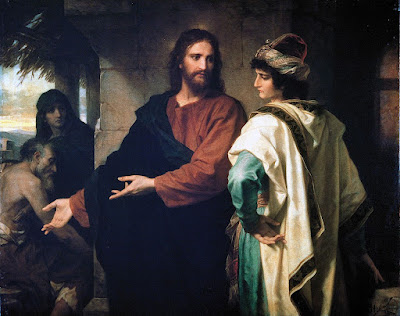Christ and The Rich Young Ruler (Mark 10:17-22) | Lectionary Images
20th Sunday after Pentecost (Proper 23, Series B)
Heinrich Hofmann (1824-1911) is known for his biblical portrayals that are often infused with emotion. You can see elements of the academic style of his training and experience of renaissance art mixed with romanticism's emphasis on human emotion. [1] This emotional appeal is often seen as the reason for the popularity of his artwork. However, it has become common for those "in the know" to disregard such popular images as being overly sentimental bordering on the kitsch. I even mentioned in a previous post that I am not quite certain that his Christ in Gethsemane really captures the biblical account of Christ's agony in the garden well. Christ is depicted with an almost serene bedside posture of prayer (though there is a sense of concern in his face). However, it is also important not to disregard the popular simply because it is popular.
All of that said, I think that this painting does something different. Our text reads:
"17 And as he was setting out on his journey, a man ran up and knelt before him and asked him, “Good Teacher, what must I do to inherit eternal life?” 18 And Jesus said to him, “Why do you call me good? No one is good except God alone. 19 You know the commandments: ‘Do not murder, Do not commit adultery, Do not steal, Do not bear false witness, Do not defraud, Honor your father and mother.’ ” 20 And he said to him, “Teacher, all these I have kept from my youth.” 21 And Jesus, looking at him, loved him, and said to him, “You lack one thing: go, sell all that you have and give to the poor, and you will have treasure in heaven; and come, follow me.” 22 Disheartened by the saying, he went away sorrowful, for he had great possessions" (Mark 10:17-22, ESV).
The rich young man is dressed in such fine clothing: the embroidered hem on his outer garment, the vibrant colors, and the jewels in his headwear. Hofmann even has the light shining upon him, emphasizing his presence and stature in this scene. However, his posture speaks of his unwillingness to consider Jesus' call. His left wrist is bent back on his side so as to refrain from making a move. His right hand is still reaching back into the darkness and lightly resting on the stone. His turned head is unwilling to even look at Jesus or the poor. It all reveals his answer. The only thing keeping this man from following Jesus is himself. When you look at his face, you see that he indeed is sorrowful. Is it sorrow that is conflicted? Is it sorrow in not receiving the kind of response from Jesus that he wanted? Is it a little of both? The true sadness of this scene is that the young man refuses the greatest of all treasures in Jesus and Him alone.
But Jesus, while humble in appearance (even with an understated halo) is still commanding the presence of the scene as He entreats the young man to come follow Him and gestures toward the two poor figures in the background. Mark tells us that Jesus "looked at" him. The Greek verb has a certain intensity and direction to it, meaning to look in the face, straight at, or directly at. When you combine this with the fact that Jesus "loved" him, Hofmann appears to have captured it all in his depiction of Jesus' eyes. Many have noted that the detail of Christ's head from this painting has been reproduced widely in a similar way to that of Warner Sallman's Head of Christ [2]. In this painting, Christ's eyes are filled with compassion. Even in the midst of the man's refusal of the call, Jesus still loves him and is gesturing to give up the one thing that has gotten between this man and Jesus. At this point in the depiction, there is still time to drop it all and follow Jesus.
As has been noted by others, Hofmann has managed to communicate both the sorrow of the man's refusal and the compassion of our Lord's call in one scene. For us, we ought to ultimately be drawn to our Lord's compassion manifest in its fullness on the cross. There, He gave up His very life for the sake of all—rich, poor, and everyone in between—in order to bring redemption through the free gift of forgiveness of our sins. By the work of the Holy Spirit, may the Lord work to release our grip on anything that may get in the way of following Jesus. Today, His compassionate call is still offered to all until His glorious return. Today is the day of salvation, because we have His call and promises before us in His Word.
Notes:
Painting - Heinrich Hofmann. Christ and the Rich Young Ruler (1889). The Riverside Church / Wikimedia Commons.
[1] See a brief bibliography here: http://www.heinrichhofmann.net/biography.html
[2] See David Morgan's Visual Piety and the connection to Warner Sallman's Head of Christ.


